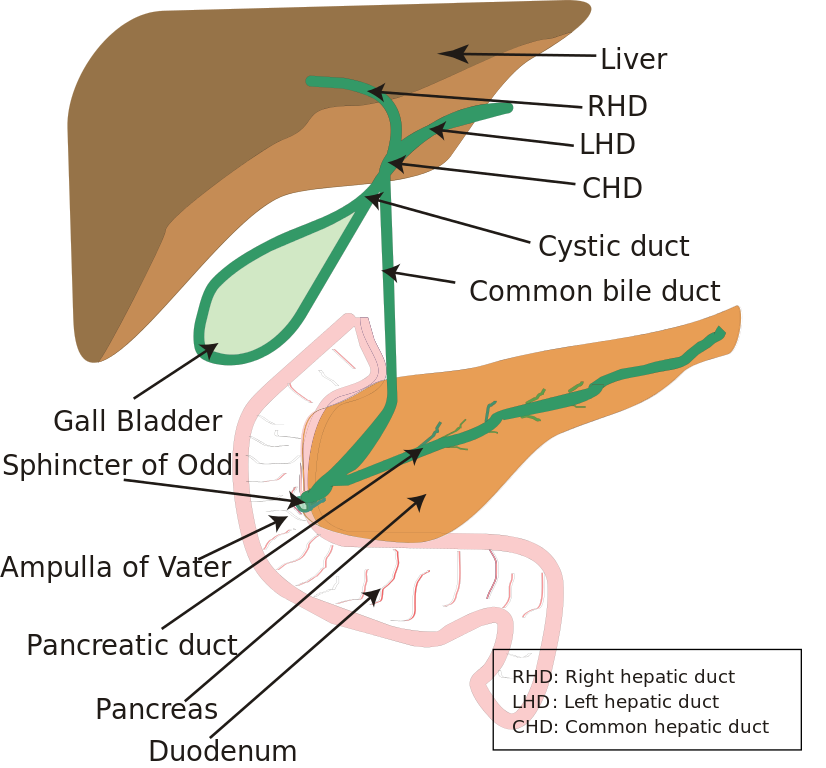[1]
Garg S, Kumar H, Sahni D, Yadav TD, Aggarwal A, Gupta T. Rare anatomic variations of the right hepatic biliary system. Surgical and radiologic anatomy : SRA. 2019 Sep:41(9):1087-1092. doi: 10.1007/s00276-019-02260-5. Epub 2019 May 21
[PubMed PMID: 31115596]
[2]
Kafle A, Adhikari B, Shrestha R, Ranjit N. Anatomic Variations of the Right Hepatic Duct: Results and Surgical Implications From a Cadaveric Study. Journal of Nepal Health Research Council. 2019 Apr 28:17(1):90-93. doi: 10.33314/jnhrc.2012. Epub 2019 Apr 28
[PubMed PMID: 31110384]
[3]
Chehade M, Kakala B, Sinclair JL, Pang T, Al Asady R, Richardson A, Pleass H, Lam V, Johnston E, Yuen L, Hollands M. Intraoperative detection of aberrant biliary anatomy via intraoperative cholangiography during laparoscopic cholecystectomy. ANZ journal of surgery. 2019 Jul:89(7-8):889-894. doi: 10.1111/ans.15267. Epub 2019 May 13
[PubMed PMID: 31083792]
[4]
Vosshenrich J, Boll DT, Zech CJ. [Passive and active magnetic resonance cholangiopancreatography : Technique, indications, and typical anatomy]. Der Radiologe. 2019 Apr:59(4):306-314. doi: 10.1007/s00117-019-0507-8. Epub
[PubMed PMID: 30859236]
[5]
Ramesh Babu CS, Sharma M. Biliary tract anatomy and its relationship with venous drainage. Journal of clinical and experimental hepatology. 2014 Feb:4(Suppl 1):S18-26. doi: 10.1016/j.jceh.2013.05.002. Epub 2013 May 25
[PubMed PMID: 25755590]
[6]
Vellar ID. The blood supply of the biliary ductal system and its relevance to vasculobiliary injuries following cholecystectomy. The Australian and New Zealand journal of surgery. 1999 Nov:69(11):816-20
[PubMed PMID: 10553973]
[7]
Couinaud C. The parabiliary venous system. Surgical and radiologic anatomy : SRA. 1988:10(4):311-6
[PubMed PMID: 3145573]
[8]
Vellar ID. Preliminary study of the anatomy of the venous drainage of the intrahepatic and extrahepatic bile ducts and its relevance to the practice of hepatobiliary surgery. ANZ journal of surgery. 2001 Jul:71(7):418-22
[PubMed PMID: 11450918]
[9]
Choi JW, Kim TK, Kim KW, Kim AY, Kim PN, Ha HK, Lee MG. Anatomic variation in intrahepatic bile ducts: an analysis of intraoperative cholangiograms in 300 consecutive donors for living donor liver transplantation. Korean journal of radiology. 2003 Apr-Jun:4(2):85-90
[PubMed PMID: 12845303]
[10]
Hyodo T, Kumano S, Kushihata F, Okada M, Hirata M, Tsuda T, Takada Y, Mochizuki T, Murakami T. CT and MR cholangiography: advantages and pitfalls in perioperative evaluation of biliary tree. The British journal of radiology. 2012 Jul:85(1015):887-96. doi: 10.1259/bjr/21209407. Epub 2012 Mar 14
[PubMed PMID: 22422383]
[11]
Mortelé KJ, Ros PR. Anatomic variants of the biliary tree: MR cholangiographic findings and clinical applications. AJR. American journal of roentgenology. 2001 Aug:177(2):389-94
[PubMed PMID: 11461869]
[12]
Benson EA, Page RE. A practical reappraisal of the anatomy of the extrahepatic bile ducts and arteries. The British journal of surgery. 1976 Nov:63(11):853-60
[PubMed PMID: 1000180]
[13]
Pucher PH, Brunt LM, Davies N, Linsk A, Munshi A, Rodriguez HA, Fingerhut A, Fanelli RD, Asbun H, Aggarwal R, SAGES Safe Cholecystectomy Task Force. Outcome trends and safety measures after 30 years of laparoscopic cholecystectomy: a systematic review and pooled data analysis. Surgical endoscopy. 2018 May:32(5):2175-2183. doi: 10.1007/s00464-017-5974-2. Epub 2018 Mar 19
[PubMed PMID: 29556977]
Level 1 (high-level) evidence
[14]
Southern Surgeons Club. A prospective analysis of 1518 laparoscopic cholecystectomies. The New England journal of medicine. 1991 Apr 18:324(16):1073-8
[PubMed PMID: 1826143]
[15]
Zarin M, Khan MA, Khan MA, Shah SAM. Critical view of safety faster and safer technique during laparoscopic cholecystectomy? Pakistan journal of medical sciences. 2018 May-Jun:34(3):574-577. doi: 10.12669/pjms.343.14309. Epub
[PubMed PMID: 30034418]
[16]
Cohen JT, Charpentier KP, Beard RE. An Update on Iatrogenic Biliary Injuries: Identification, Classification, and Management. The Surgical clinics of North America. 2019 Apr:99(2):283-299. doi: 10.1016/j.suc.2018.11.006. Epub 2019 Feb 10
[PubMed PMID: 30846035]
[17]
Bauschke A. [Biliary system : What does the surgeon want to know from the radiologist?]. Der Radiologe. 2019 Apr:59(4):300-305. doi: 10.1007/s00117-019-0502-0. Epub
[PubMed PMID: 30820620]
[18]
Kimura Y, Takada T, Kawarada Y, Nimura Y, Hirata K, Sekimoto M, Yoshida M, Mayumi T, Wada K, Miura F, Yasuda H, Yamashita Y, Nagino M, Hirota M, Tanaka A, Tsuyuguchi T, Strasberg SM, Gadacz TR. Definitions, pathophysiology, and epidemiology of acute cholangitis and cholecystitis: Tokyo Guidelines. Journal of hepato-biliary-pancreatic surgery. 2007:14(1):15-26
[PubMed PMID: 17252293]
[19]
Gottesman LE, Del Vecchio MT, Aronoff SC. Etiologies of conjugated hyperbilirubinemia in infancy: a systematic review of 1692 subjects. BMC pediatrics. 2015 Nov 20:15():192. doi: 10.1186/s12887-015-0506-5. Epub 2015 Nov 20
[PubMed PMID: 26589959]
Level 1 (high-level) evidence
[20]
Caton AR, Druschel CM, McNutt LA. The epidemiology of extrahepatic biliary atresia in New York State, 1983-98. Paediatric and perinatal epidemiology. 2004 Mar:18(2):97-105
[PubMed PMID: 14996248]
[21]
Hart MH, Kaufman SS, Vanderhoof JA, Erdman S, Linder J, Markin RS, Kruger R, Antonson DL. Neonatal hepatitis and extrahepatic biliary atresia associated with cytomegalovirus infection in twins. American journal of diseases of children (1960). 1991 Mar:145(3):302-5
[PubMed PMID: 1848391]
[22]
Harper P, Plant JW, Unger DB. Congenital biliary atresia and jaundice in lambs and calves. Australian veterinary journal. 1990 Jan:67(1):18-22
[PubMed PMID: 2334368]
[23]
Lorent K, Gong W, Koo KA, Waisbourd-Zinman O, Karjoo S, Zhao X, Sealy I, Kettleborough RN, Stemple DL, Windsor PA, Whittaker SJ, Porter JR, Wells RG, Pack M. Identification of a plant isoflavonoid that causes biliary atresia. Science translational medicine. 2015 May 6:7(286):286ra67. doi: 10.1126/scitranslmed.aaa1652. Epub
[PubMed PMID: 25947162]
[24]
Cannella R, Giambelluca D, Diamarco M, Caruana G, Cutaia G, Midiri M, Salvaggio G. Congenital Cystic Lesions of the Bile Ducts: Imaging-Based Diagnosis. Current problems in diagnostic radiology. 2020 Jul-Aug:49(4):285-293. doi: 10.1067/j.cpradiol.2019.04.005. Epub 2019 Apr 6
[PubMed PMID: 31027922]
[27]
Clemente G, Tringali A, De Rose AM, Panettieri E, Murazio M, Nuzzo G, Giuliante F. Mirizzi Syndrome: Diagnosis and Management of a Challenging Biliary Disease. Canadian journal of gastroenterology & hepatology. 2018:2018():6962090. doi: 10.1155/2018/6962090. Epub 2018 Aug 12
[PubMed PMID: 30159303]

